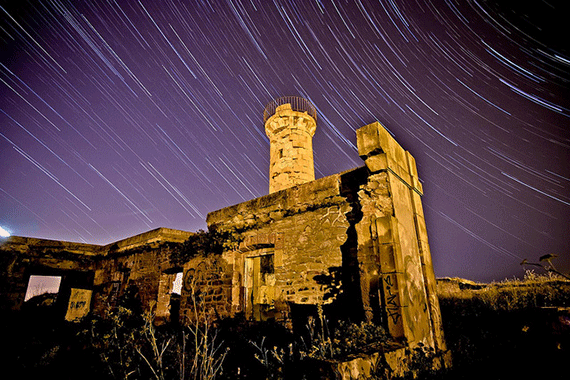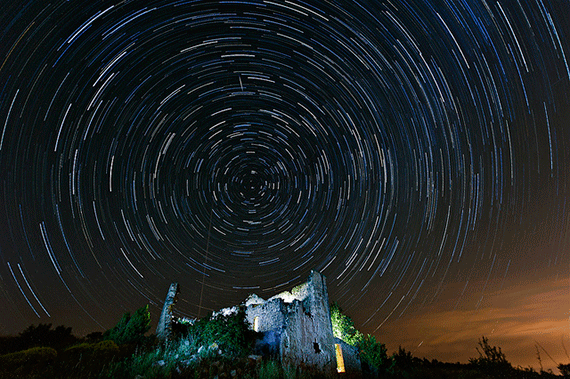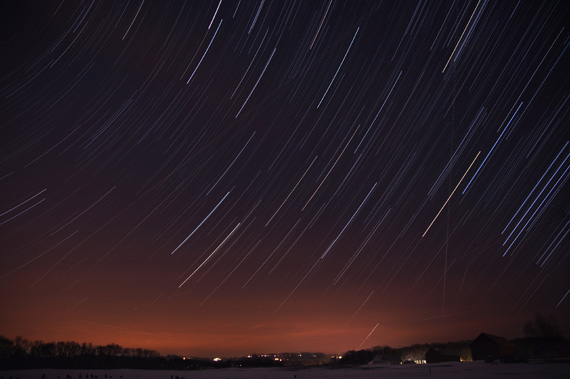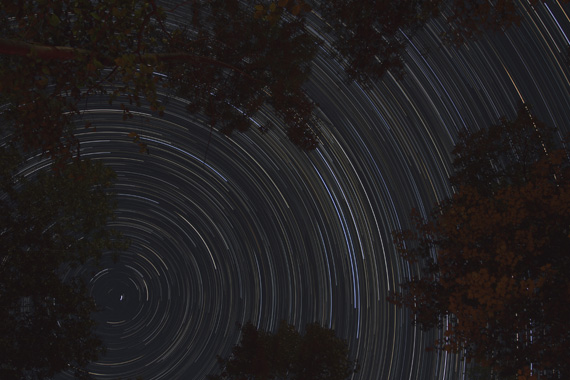One of the lessons in the Photography Lab series I teach is a lesson on night photography, specifically shooting the stars. There are two essentials to know before going out to shoot stars your first time.

Photo by Aitor Aguirregabiria; ISO 200, f/3.5.
ONE: The Earth is rotating. This means you can photograph star constellations, but after about 15 seconds, you will start to get blurring in your stars because of the movement of the Earth.
TWO: You should know a couple of constellations before you go out: the Big Dipper and Orion are the two I use to orient myself.
Why the Orion and The Big Dipper? First, they are extremely bright and easily found in the night sky. Second, besides being my favorite constellation, Orion is usually high enough in the sky to photograph with other stars around, but it can also sit low so you can get nice foreground elements in your compositions. Finally, use the two stars which make up the pouring end of the Big Dipper to find the North Star. Look at the bottom star in the dipper part of The Big Dipper, the non-handle end. Draw a from the bottom star in the dipper to the top star in the dipper, then continue this line until you see the Little Dipper. This line (and these two stars) point to the last star in the handle of the Little Dipper. Why is this important? The last star in the handle of the Little Dipper is Polaris – the North Star.
If you know where Polaris (The North Star) is located, you can point your camera in this direction and, using long exposure times, you will get circular star trails instead of blurry constellations.

Photo by Miquel González Page; ISO 200, f/2.8.
When I shoot stars, I use two lenses: a Canon 10–22mm and a Tamaron 28–300, which I use in the 28mm–80mm range.
I set my camera to M (manual) and use the following settings:
- Aperture: widest setting f/2.8 | f/3.5 | f/5.0 depending on focal length
- ISO: 100 or 200
- Shutter Speed: BULB setting
- White Balance: Auto or Tungsten
- Focusing: Manual / Infinity
Some other items you may want to bring along:
- Small flashlight. You can see your gear, get things set up, change your camera settings, and change your release cable settings. You can use the flashlight to do a sweep of the ground before you leave to make sure you didn’t leave anything behind. Use the flashlight to paint the foreground with light to give your photographs more compositional drama.
- Small laser pointer. I haven’t tried this yet, but when I was shooting tonight, I couldn’t see what I was composing through the viewfinder. It’s dark outside when you’re photographing stars! I would take 30 second–45 second photographs to test my compositions. I wondered about using a small laser pointer to hold on top of my lens to see exactly where the lens is pointing.
- Chair. You’ll be using loooong shutter speeds. You are going to want to sit. Well, I would want one. I want to look up and not get dizzy. A lounge chair is even better! Of course, if you’ve driven to a remote location, you can always sit in your car while waiting for exposures to take.
- Shutter release cable. Some DSLRs have shutter release cables to trigger the shutter. Some you can even set up to take a photo every X minutes with an exposure time of X up to 99h 99m 99s.
- Stop Watch. Most cameras have a 15min shutter speed max – but do have a bulb setting you can use if you want longer exposure times but don’t have a shutter release cable. In bulb, you shutter will open once you press the shutter button – and will not close until you press the shutter button again. If you use BULB – you may want a stop watch to help keep track of your exposure time.
- Blanket. It’s January, and here in New England, it’s COLD in the wee hours of the morning. In addition to a nice coat/jacket, I’ll have a blanket to wrap up in and help stay toasty.
- Hot Chocolate / Coffee / Tea. Did I mention it’s cold in the middle of the night?! Plus—it’s the middle of the night! And I’m bundled up toasty and warm on a lounge chair, staring at stars. Going to need something to help keep me awake.
- Tripod. Yes, I know. I said it: tripod. Former students, it’s okay. I know I preach the power of less-is-more, but in this case, you will definitely need a tripod. You’re going to also need a tripod which swivels so you can point you camera in the right direction. Night shots of star trails and meteor showers require LONG exposures. A rock or car roof won’t work here.
- Friend. Take a friend to share the experience with you. You’ll have someone to talk to (and help keep you from getting bored while you wait for those 1 and 2 hour exposures) and you’ll have great story to tell about taking tons of photographs of stars and meteors and of course – you’ll have the great shots you take too!!
- Camera / Lens. You can’t really take photographs if you don’t have your camera… been there—couldn’t photograph that!!
- Memory Cards. Make sure you have a large memory card available and have an extra one just in case.
- Batteries. How many?? Three. Where are they? Charged, set in the camera. Charged, set in your pocket. Set charging in charger. Really, I can’t stress extra batteries for night photography enough. Keeping the shutter open for long periods of time sucks up TONS of battery energy. Where a battery will last you for 6 hours of event photography, you might get 2 or 3 hours of night photography.
Follow me as I continue to experiment with star photography techniques. You can see my attempts (success and failures) in the gallery at https://ift.tt/1KPkIIu.
Now you know what gear you need, what settings to use, and where to point your camera. It’s time to get out there and try some star photography for yourself!
About the Author:
Professional photographer Loreen Liberty (litewriting dot com) has been taking photographs since her early teens, and in the professional industry for the past nine year. After many successful years as a wedding and portrait photographer, Loreen decided to turn her attentions to teaching photography full time. “It gives me more time to practice my craft and be artistic for myself.
Go to full article: Star Trail Photography Tips
What are your thoughts on this article? Join the discussion on Facebook
PictureCorrect subscribers can also learn more today with our #1 bestseller: The Photography Tutorial eBook
The post Star Trail Photography Tips appeared first on PictureCorrect.
from PictureCorrect https://ift.tt/2HyB91C
via IFTTT








0 kommenttia:
Lähetä kommentti